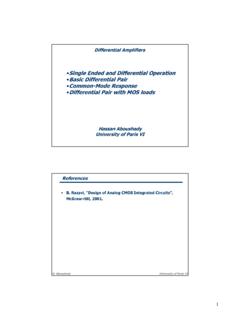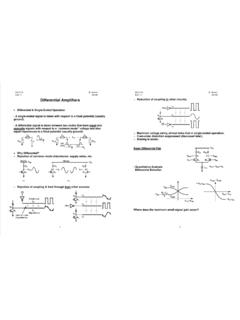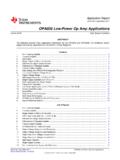Transcription of JEDEC STANDARD - National Tsing Hua University
1 JEDEC . STANDARD . DDR2 SDRAM SPECIFICATION. JESD79-2E. (Revision of JESD79-2D). April 2008. JEDEC SOLID STATE TECHNOLOGY ASSOCIATION. NOTICE. JEDEC standards and publications contain material that has been prepared, reviewed, and approved through the JEDEC Board of Directors level and subsequently reviewed and approved by the JEDEC legal Counsel. JEDEC standards and publications are designed to serve the public interest through eliminating misunderstandings between manufacturers and purchasers, facilitating interchangeability and improvement of products, and assisting the purchaser in selecting and obtaining with minimum delay the proper product for use by those other than JEDEC members, whether the STANDARD is to be used either domestically or internationally. JEDEC standards and publications are adopted without regard to whether or not their adoption may involve patents or articles, materials, or processes. By such action JEDEC does not assume any liability to any patent owner, nor does it assume any obligation whatever to parties adopting the JEDEC standards or publications.
2 The information included in JEDEC standards and publications represents a sound approach to product specification and application, principally from the solid state device manufacturer viewpoint. Within the JEDEC organization, there are procedures whereby a JEDEC STANDARD or publication may be further processed and ultimately become an ANSI STANDARD . No claims to be in conformance with this STANDARD may be made unless all requirements stated in the STANDARD are met. Inquiries, comments, and suggestions relative to the content of this JEDEC STANDARD or publication should be addressed to JEDEC at the address below, or call (703) 907-7559 or Published by JEDEC Solid State Technology Association 2008. 2500 Wilson Boulevard Arlington, VA 22201-3834. This document may be downloaded free of charge, however JEDEC retains the copyright on this material. By downloading this file the individual agrees not to charge for or resell the resulting material. Price: Please refer to the current Catalog of JEDEC Engineering standards and Publications online at Printed in the All rights reserved PLEA SE!
3 D O N 'T V IO L A T E. THE. LA W ! T h is d o c u m e n t is c o p yrig h te d b y th e E le c tro n ic In d u strie s A llia n c e a n d m a y n o t b e re p ro d u c e d w ith o u t p e rm iss io n . O rg a n iz a tio n s m a y o b ta in p e rm is sio n to re p ro d u c e a lim ite d n u m b e r o f c o p ie s th ro u g h e n te rin g in to a lic e n s e a g re e m e n t. F o r in fo rm a tio n , c o n ta c t: J E D E C S o lid S ta te T e c h n o lo g y A s s o c ia tio n 2 5 0 0 W ils o n B o u le v a rd A rlin g to n , V irg in ia 2 2 2 0 1 -3 8 3 4. o r c a ll (7 0 3 ) 9 0 7 -7 5 5 9. JEDEC STANDARD No. 79-2E. Contents 1 Scope .. 1. 2 Package ballout & addressing .. 2. DDR2 SDRAM package ballout .. 2. Quad-stacked/quad-die DDR2 SDRAM internal rank associations .. 11. Input/output functional description .. 13. DDR2 SDRAM addressing .. 14. 3 Functional description .. 16. Simplified state diagram .. 16. Basic functionality .. 16. Power-up and initialization .. 16. Power-up and initialization sequence.
4 17. Programming the mode and extended mode registers .. 18. DDR2 SDRAM mode register (MR) .. 18. DDR2 SDRAM extended mode registers (EMR(#)) .. 19. Off-chip driver (OCD) impedance adjustment .. 24. ODT (on-die termination) .. 27. ODT related timings .. 27. Bank activate command .. 32. Read and write access modes .. 32. Posted CAS .. 32. Burst mode operation .. 34. Burst read command .. 34. Burst write operation .. 37. Write data mask .. 40. Precharge operation .. 41. Burst read operation followed by precharge .. 42. Burst write followed by precharge .. 44. Auto precharge operation .. 45. Burst read with auto precharge .. 46. Burst write with auto precharge .. 48. Refresh command .. 49. Self refresh operation .. 50. Power-down .. 51. Asynchronous CKE LOW event .. 55. Input clock frequency change during precharge power down .. 56. SSC (Spread Spectrum Clocking) .. 57. Terms and definitions .. 57. SSC (Spread Spectrum Clocking) Criteria .. 57. Allowed SSC band .. 57. No operation command.
5 57. Deselect command .. 57. 4 Truth tables .. 58. Command truth table .. 58. Clock enable truth table.. 59. Data mask truth table.. 60. 5 Absolute maximum DC ratings .. 61. 6 AC & DC operating conditions .. 62. Annex A (informative) Differences between JESD79-2E and 109. -i- JEDEC STANDARD No. 79-2E. Figures 1 DDR2 SDRAM x4 ballout using MO-207 .. 2. 2 DDR2 SDRAM x8 ballout using MO-207 .. 3. 3 DDR2 SDRAM x16 ballout using MO-207 .. 4. 4 Stacked/dual-die DDR2 SDRAM x4 ballout using MO-242 .. 5. 5 Stacked/dual-die DDR2 SDRAM x8 ballout using MO-242 .. 6. 6 Stacked/dual-die DDR2 SDRAM x16 ballout using MO-242 .. 6. 7 Quad-stacked/quad-die DDR2 SDRAM x4 ballout using MO-242 .. 8. 8 Quad-stacked/quad-die DDR2 SDRAM x8 ballout using MO-242 .. 9. 9 Quad-stacked/quad-die DDR2 SDRAM x16 ballout using MO-242 .. 10. 10 Quad-stacked/quad-die DDR2 SDRAM x4 rank association .. 11. 11 Quad-stacked/quad-die DDR2 SDRAM x8 rank association .. 11. 12 Quad-stacked/quad-die DDR2 SDRAM x16 rank association.
6 12. 13 DDR2 SDRAM simplified state diagram .. 16. 14 Initialization sequence after power-up .. 18. 15 DDR2 SDRAM mode register set (MRS) .. 19. 16 EMR(1) programming .. 21. 17 EMR(2) programming .. 23. 18 EMR(3) programming .. 24. 19 OCD impedance adjustment .. 24. 20 OCD adjust mode .. 26. 21 OCD drive mode .. 26. 22 Functional representation of ODT .. 27. 23 ODT update delay timing - tMOD .. 28. 24 ODT update delay timing - tMOD, as measured from outside .. 28. 25 ODT timing for active/standby mode .. 29. 26 ODT timing for power-down mode .. 29. 27 ODT timing mode switch at entering power-down mode .. 30. 28 ODT timing mode switch at exiting power-down mode .. 31. 29 Bank activate command cycle: tRCD = 3, AL = 2, tRP = 3, tRRD = 2, tCCD = 2 .. 32. 30 Example 1: Read followed by a write to the same bank, where AL = 2 and CL = 3, RL = (AL + CL) = 5, WL = (RL - 1) = 4, BL = 4 .. 33. 31 Example 2: Read followed by a write to the same bank, where AL = 0 and CL = 3, RL = (AL + CL) = 3, WL = (RL - 1) = 2, BL = 4.
7 33. 32 Data output (read) timing .. 35. 33 Burst read operation: RL = 5 (AL = 2, CL = 3, BL = 4) .. 35. 34 Burst read operation: RL = 3 (AL = 0 and CL = 3, BL = 8) .. 35. 35 Burst read followed by burst write: RL = 5, WL = (RL-1) = 4, BL = 4 .. 36. 36 Seamless burst read operation: RL = 5, AL = 2, and CL = 3, BL = 4 .. 36. 37 Read burst interrupt timing example: (CL=3, AL=0, RL=3, BL=8) .. 37. 38 Data input (write) timing .. 38. 39 Burst write operation: RL = 5 (AL=2, CL=3), WL = 4, BL = 4 .. 38. 40 Burst write operation: RL = 3 (AL=0, CL=3), WL = 2, BL = 4 .. 38. 41 Burst write followed by burst read: RL = 5 (AL=2, CL=3), WL = 4, tWTR = 2, BL = 4 .. 39. 42 Seamless burst write operation: RL = 5, WL = 4, BL = 4 .. 39. 43 Write burst interrupt timing example: (CL=3, AL=0, RL=3, WL=2, BL=8) .. 40. 44 Write data mask .. 41. 45 Example 1: Burst read operation followed by precharge: RL = 4, AL = 1, CL = 3, BL = 4, tRTP <= 2 clocks .. 42. 46 Example 2: Burst read operation followed by precharge: RL = 4, AL = 1, CL = 3, BL = 8, tRTP <= 2 clocks.
8 43. 47 Example 3: Burst read operation followed by precharge: RL = 5, AL = 2, CL = 3, BL = 4, tRTP <= 2 clocks .. 43. -ii- JEDEC STANDARD No. 79-2E. Figures 48 Example 4: Burst read operation followed by precharge: RL = 6, AL = 2, CL = 4, BL = 4, tRTP <= 2 clocks .. 44. 49 Example 5: Burst read operation followed by precharge: RL = 4, AL = 0, CL = 4, BL = 8, tRTP > 2 clocks .. 44. 50 Example 1: Burst write followed by precharge: WL = (RL-1) =3 .. 45. 51 Example 2: Burst write followed by precharge: WL = (RL-1) = 4 .. 45. 52 Example 1: Burst read operation with auto precharge: RL = 4, AL = 1, CL = 3, BL = 8, tRTP <= 2 clocks .. 46. 53 Example 2: Burst read operation with auto precharge: RL = 4, AL = 1, CL = 3, BL = 4, tRTP > 2 clocks .. 47. 54 Example 3: Burst read with auto precharge followed by an activation to the same bank (tRC Limit): RL = 5 (AL = 2, CL = 3, internal tRCD = 3, BL = 4, tRTP <= 2 clocks) .. 47. 55 Example 4: Burst read with auto precharge followed by an activation to the same bank (tRP Limit): RL = 5 (AL = 2, CL = 3, internal tRCD = 3, BL = 4, tRTP <= 2 clocks).
9 48. 56 Burst write with auto-precharge (tRC Limit): WL = 2, WR = 2, BL = 4, tRP = 3 .. 48. 57 Burst write with auto-precharge (WR + tRP): WL = 4, WR = 2, BL = 4, tRP = 3 .. 49. 58 Refresh command .. 50. 59 Self refresh operation .. 51. 60 Basic power down entry and exit timing diagram .. 52. 61 Example 1 of CKE intensive environment .. 52. 62 Example 2 of CKE intensive environment .. 52. 63 Read to power-down entry .. 53. 64 Read with autoprecharge to power-down entry .. 53. 65 Write to power-down entry .. 54. 66 Write with autoprecharge to power-down entry .. 54. 67 Refresh command to power-down entry .. 55. 68 Active command to power-down entry .. 55. 69 Precharge/precharge-all command to power-down entry .. 55. 70 MRS/EMRS command to power-down entry .. 55. 71 Asynchronous CKE LOW event .. 56. 72 Clock frequency change in precharge power-down mode .. 56. 73 AC input test signal waveform .. 64. 74 Differential signal levels .. 65. 75 AC overshoot and undershoot definition for address and control pins.
10 66. 76 AC overshoot and undershoot definition for clock, data, strobe, and mask pins .. 66. 77 DDR2 default pulldown characteristics for full strength driver .. 69. 78 DDR2 default pullup characteristics for full strength output driver .. 70. 79 DDR2 default pulldown characteristics for reduced strength drive .. 71. 80 DDR2 default pullup characteristics for reduced strength driver .. 72. 81 AC timing reference load .. 83. 82 Slew rate test load .. 83. 83 Data Input (Write) Timing .. 84. 84 Data output (read) timing .. 84. 85 Illustration of nominal slew rate for tDS (differential DQS, DQS) .. 87. 86 Illustration of nominal slew rate for tDS (single-ended DQS) .. 88. 87 Illustration of tangent line for tDS (differential DQS, DQS) .. 89. 88 Illustration of tangent line for tDS (single-ended DQS) .. 90. 89 Illustration of nominal slew rate for tDH (differential DQS, DQS) .. 91. 90 Illustration of nominal slew rate for tDH (single-ended DQS) .. 92. 91 Illustration tangent line for tDH (differential DQS, DQS).





